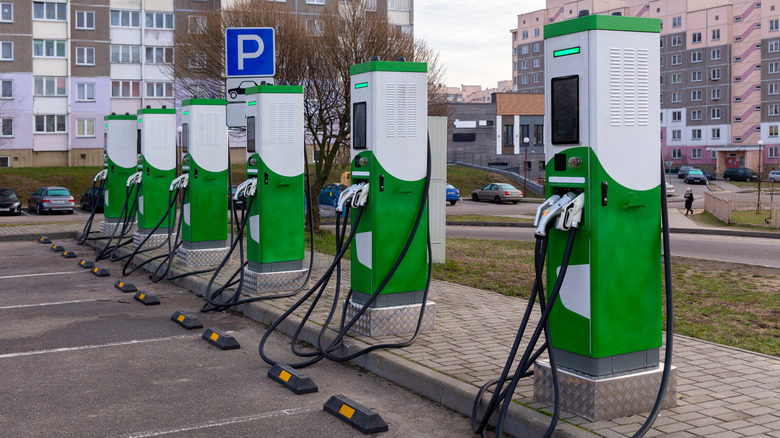Seen One Of These Unique EV Chargers While Traveling? They're Battery-Buffered Stations, And Here's How They Work
There's an unusual type of electric vehicle (EV) charger showing up on the highways of America. One was recently seen and reported on via TikTok by roadtripper Taylor (@taylorandzervan), who spotted it in Ohio. This type of charger is known as a battery-buffered charger, combining the low-speed input of a Level 2 charger with the high-speed output of a DC fast charger, which combines two of the 3 levels of EV charging. It accomplishes this through the use of a battery that is built into the charger, which is slowly charged at a Level 2 rate of charge. When the battery has a full charge, it can be quickly discharged at a rate of 150 kW or more, rapidly charging a waiting EV in a short amount of time.
The benefits of battery-buffered chargers will be most appreciated in areas where the electrical grid may not be robust enough to support the high-voltage needs of a DC fast charging station, as well as in remote locations that don't have access to that level of power. A battery-buffered charging station can operate on an easily available, 240-volt Level 2 system, which does not need the expensive distribution feeders and new transformers required with a high-voltage DC power supply. The batteries inside the chargers simply need to be fully charged before the fast charging can begin, which makes this a good solution for the 5 US states with the fewest public EV chargers. Current providers of battery-buffered chargers include ADS-TEC Energy, TUAL, Orange EV's Optigrid, and Jolt in Europe.
What are the downsides of battery-buffered EV charging stations?
While battery-buffered chargers have some notable benefits like putting less load on the electrical grid, costing less to install, and having shorter installation times, there is a major downside to this type of charger. Let's say that you need to charge your EV and you pull into one of these battery-buffered chargers, right after the EV ahead of you has gotten a fast charge. If the battery-buffered charger has an undersized battery or if the charger is not being managed properly, there may be no fast charging capacity left when you need to charge your EV and be on your way. Without any battery reserve left for your EV, the result will be much lower charging speeds on par with a Level 2 charger — we are talking hours now, not minutes.
Another downside of battery-buffered chargers is directly related to the battery energy storage system. The battery can become a point of failure, either disabling the charger or limiting it to a slow Level 2 capacity. And since it's still early days for the charging industry, there will be company failures — buffered-charger company Freewire announced its closure and layoff of all employees on June 24, 2024. Fortunately, Orange EV, a maker of electric terminal tractors, acquired the Freewire tech as a way to speed up charger installation times for its customers, getting its vehicles on the job faster. This was a happier ending than when one of the most recommended charger companies abandoned its American users.
